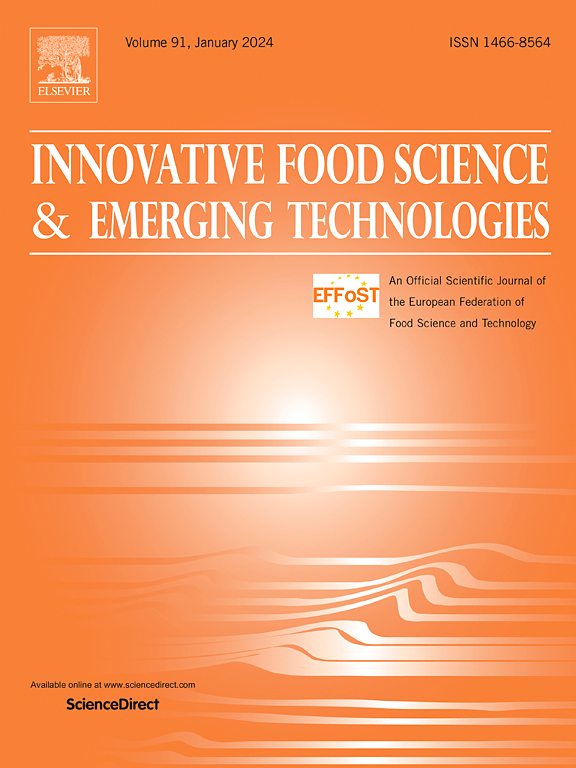Role of phosphate modification in enhancing ovalbumin fibril formation and functionality: Insights into molecular interactions and structural dynamics
IF 6.3
1区 农林科学
Q1 FOOD SCIENCE & TECHNOLOGY
Innovative Food Science & Emerging Technologies
Pub Date : 2025-03-10
DOI:10.1016/j.ifset.2025.103992
引用次数: 0
Abstract
Amyloid fibrils from proteins have garnered significant attention from researchers due to their outstanding functional properties. This study aims to investigate the effects of different sodium tripolyphosphate (STPP) concentrations (0.4 %, 4.0 %, and 8.0 %, w/v) on the formation and functional properties of ovalbumin (OVA) amyloid fibrils under heating conditions. Thioflavin T (ThT) assay revealed that the addition of STPP significantly accelerated the fibril formation potential. The fibril formation mechanism was explored through circular dichroism (CD), hydrophobic interaction, zeta potential, and Fourier transform infrared (FTIR) spectral analyses. Hydrophobic interactions and electrostatic repulsion were found to be the main driving forces for fibril formation of STPP-modified OVA (POVA). TEM results showed that STPP concentration was the key factor for regulating the morphology of OVA fibrils, with filamentous and worm-like fibrils for 0.4 % and 4.0 % POVA, respectively, while aggregated fibrils for 8.0 % POVA, due to the decrease of hydrophobic interaction and electrostatic repulsion. The 4.0 % POVA fibrils had the best emulsification capacity and foaming properties. The emulsion stabilized with 4.0 % POVA was the most stable. Overall, this study elucidated the potential formation mechanism of POVA fibrils, providing an environmentally friendly idea for preparation of OVA fibrils. Meanwhile, it had great potential as delivery systems for food constituents.
磷酸修饰在增强卵清蛋白原纤维形成和功能中的作用:分子相互作用和结构动力学的见解
淀粉样蛋白原纤维由于其突出的功能特性而引起了研究人员的极大关注。本研究旨在探讨三聚磷酸钠(STPP)浓度(0.4%、4.0%和8.0%,w/v)在加热条件下对卵清蛋白(OVA)淀粉样原纤维形成和功能特性的影响。硫黄素T (ThT)测定显示,STPP的加入显著加快了原纤维的形成潜力。通过圆二色性(CD)、疏水相互作用、ζ电位和傅里叶变换红外(FTIR)光谱分析探讨了纤维的形成机理。疏水相互作用和静电斥力是stpp修饰OVA (POVA)纤维形成的主要驱动力。TEM结果表明,由于疏水相互作用和静电斥力的减少,STPP浓度是调节OVA原纤维形态的关键因素,丝状和蠕虫状原纤维的POVA分别为0.4%和4.0%,而聚集性原纤维的POVA为8.0%。4.0% POVA原纤维的乳化能力和发泡性能最好。以4.0% POVA稳定的乳液最稳定。总的来说,本研究阐明了POVA原纤维的潜在形成机制,为OVA原纤维的制备提供了环保思路。同时,它作为食品成分的输送系统具有很大的潜力。
本文章由计算机程序翻译,如有差异,请以英文原文为准。
求助全文
约1分钟内获得全文
求助全文
来源期刊
CiteScore
12.00
自引率
6.10%
发文量
259
审稿时长
25 days
期刊介绍:
Innovative Food Science and Emerging Technologies (IFSET) aims to provide the highest quality original contributions and few, mainly upon invitation, reviews on and highly innovative developments in food science and emerging food process technologies. The significance of the results either for the science community or for industrial R&D groups must be specified. Papers submitted must be of highest scientific quality and only those advancing current scientific knowledge and understanding or with technical relevance will be considered.

 求助内容:
求助内容: 应助结果提醒方式:
应助结果提醒方式:


